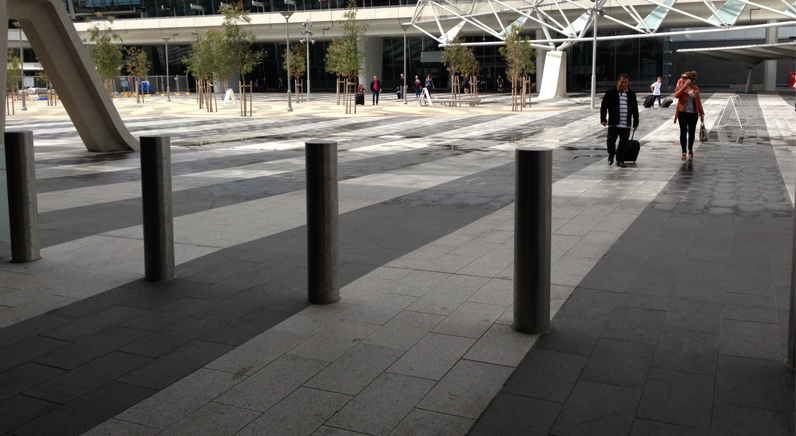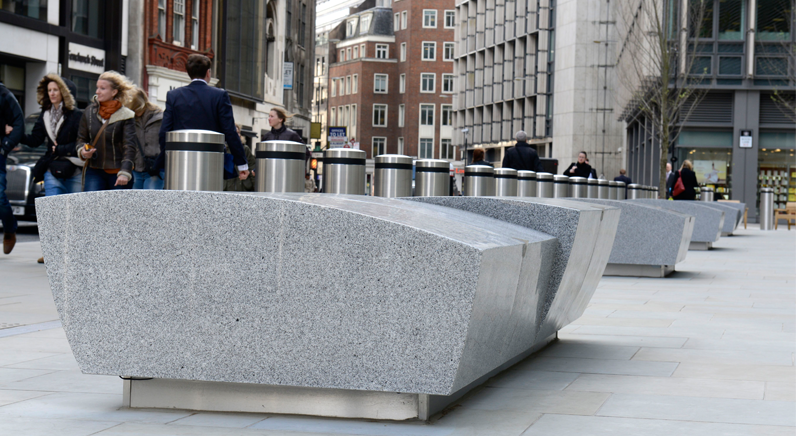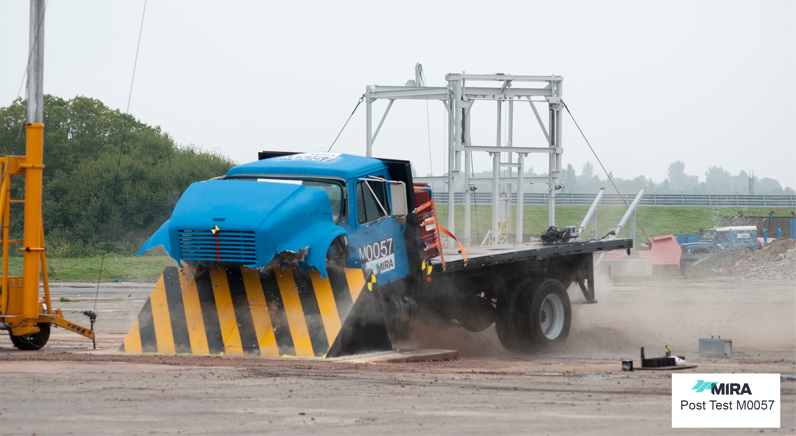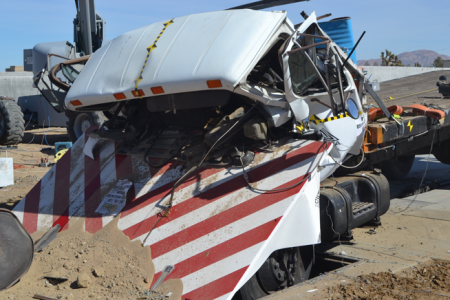Building barriers to hostile vehicles
Tim Compston of SecurityNewsDesk finds out more about the solutions that are putting the brakes on the ever present hostile vehicle threat.
As airports and other security sensitive locations look to further enhance their capabilities to stop life threatening, and property damaging, vehicle-borne attacks by terrorists, we consider the way that the design of bollards, blockers, and barriers, has changed in the wake of incidents like the Glasgow airport attack of 2007 to cope with the demands of an increasingly uncertain world.
Terminal attack
What happened at Glasgow airport back in June 2007 was a real wake-up call and, certainly, had the potential to be much worse than it turned out to be. This saw two men ramming a Jeep Cherokee carrying propane canisters into the glass doors of the terminal causing significant damage. It is reported that the security bollards outside the entrance prevented the vehicle from entering the terminal proper, which was full of passengers. In terms of injuries, the vehicle’s driver was severely burnt – and later died in hospital – and five members of the public were hurt – some while trying to apprehend the assailants – but, thankfully, none seriously.
Catalysts for action

On the ramifications of major events on the take-up of protective measures, Paul Jeffrey, managing director at Avon Barrier Corporation, says that the company saw a big ramp-up in interest from airports in hostile vehicle mitigation after 9/11 and then again post Glasgow: “We were at the forefront of what was happening anyway but Glasgow did move things on very quickly in a short space of time. There was already a programme in place to start to improve the security on access to the front of airports – some of the major airports were already working along those lines – and every airport in the UK pretty much ended up doing the same thing and protecting the frontage. So there was kind of a journey towards protection and that [Glasgow] was just the final push to get everything done.”
Fast forward to today and Jeffrey says things are starting to develop further with the creation of a stand-off where people are actually arriving and going into the terminal and that you also want to stop vehicles crashing through to the runways: “The last piece of the jigsaw in terms of protection is the perimeter fence line.”
Jeffrey also addresses the ways that the design of hostile vehicle mitigation systems has changed over time: “I think that there are really two areas, one is aesthetics and the other is the depth. Jeffrey explains that in places like central London where there are real issues with depth because of cables buried below the surface it just isn’t possible to go deep with standard bollards: “You don’t have that flexibility so a lot of the shallow stuff has been developed because of where it is going.”
For other projects without the same physical constraints Jeffrey suggests that actually following a shallow path doesn’t necessarily always stack-up: “It may appear that something which is shallow mounted is going to save pounds on installation and excavation but the reality is that in the long run it will cost them an awful lot more.” He cites the example of an airport project that Avon was bidding on: “It was a new build on a green-field site and the consultant specified super shallow bollards which had a 100 mm foundation – or something like that – and the reality was that they could have gone as deep as they wanted without any difficulty.
The cost was about £2,500 versus a deep mounted unit at around £600.” Jeffrey explains that Avon is not averse to supplying shallow bollards – as there are these type of units in its product portfolio – but the take away point here is that they shouldn’t be pushed out for applications where they are not really needed.

Better by design
Iain Moran high security manager at ATG Access says that today when developments are being built from scratch there is more awareness out there of the need to design hostile vehicle mitigation into the scheme itself: “From initial concept we are being engaged as designers and manufacturers very early on to try and design schemes that are less intrusive, we are building products into street furniture and even bus shelters now that provide the impact tested measure. Discussion always starts with what the threat level is.”
Moran says that slimmer profile and shallower products which are less intrusive are meeting ever higher performance criteria: “Our shallow technology is unique in that it is a true shallow depth. We can stop seven-and-a-half tonnes at 80 kph in as shallow as 150 mm without using any reinforced concrete or re-bar in the excavation, so it is much quicker to install and more practical in city centres such as London where there are services under the ground.” For airports, Moran feels that to minimise disruption in front of terminal buildings going shallower definitely makes sense.

Expanding on the subject of creating solutions that don’t detract from the building they are securing, when I spoke to Jonathan Goss, managing director of Townscape Products Limited, he was particularly pleased with how a famous project in Fenchurch Street, London, otherwise referred to as the ‘walkie, talkie’ building had turned out: “At the base of that are our CT blocks and what we have done is to dress the block in a very large granite top with stainless steel sides and the LED down-lighters and they look stunning in the day and night. People would walk down the street and never even realise that it was a vehicle defence product.”
Townscape has also had its fair share of success recently around airports, a case in point being the announcement back in June 2016 that it had supplied 74 of its PAS 68 Counter Terror (CT) blocks, 10 PAS 68 shallow mount bollards and a PAS 68 manual CT barrier, to stop vehicle-based attacks at East Midlands Airport. This was the third airport within the Manchester Airport Group where Townscape had provided protective measures. Speaking at the time, Jonathan Goss said that as well as defending the East Midlands Airport building it was important to provide an inclusive perimeter: “We used our PerformaCast polymer bollard sleeves to give the shallow mount bollards an aesthetically pleasing finish and to keep the maintenance cost low.” The CT blocks from Townscape were placed in front of the building as both a strong visual deterrent and to provide seating for pedestrians waiting in the pick-up area.
Testing times
Touching on the international standards and tests that prospective purchasers should be looking out for the latest HVM solutions to meet, Debbie Heald, director at Heald Ltd, says: “There are various standards available which basically test the barriers ability to withstand a particular impact of a certain type of vehicle at a specific speed. The European standard is IWA which we test to, however there is PAS 68 and also the standards in the US. In my opinion the customer should be looking at two things, firstly what do they need for their site? What vehicle? What speed? As there are different tests they also need to focus on the performance classification which will identify exactly how the barrier has performed and they can assess if it is suitable for their required location.”

For a greater insight into what is happening on the testing front in the UK and Europe I turned to TRL, the UK’s Transport Research Laboratory. Euan Fraser, consultant engineer, says that TRL was instrumental in getting standard building to standards like IWA 14-1:2013, most recently, and with the PAS68 standard over the last 10 years: “I guess in terms of how the standards have developed IWA 14-1 was conceived to bring together the PAS68 standard and the ASTM 2656 standard – the American one. This was really to make it easier for the end user, the specifier and the manufacturer to meet the criteria of what were previously two very disparate markets.”
Regarding where the demand is for testing, interestingly, TRL is reporting that the last 14 months has seen an increase in the number of their manufacturing customers asking for product tests to the ‘harmonised’ IWA 14-1:2013 standards rather than PAS68:2013 or ASTM 2656-07.

Shallower solutions
Across the Atlantic in the US, Keith Bobrosky, sales manager – high security systems – at Delta Scientific Corporation outlines the path being taken by Delta Scientific’s barriers. He reports that over the last few years the design of the company’s barriers has really focused on shallow technology: “This is mainly for barriers and even more importantly bollards. That has a direct relationship for airport security because most airports that we deal with the arrivals and departures areas where they want to protect most with bollards often have infrastructure in the ground or it is a raised deck so there is very little room for a raised bollard.” He goes on to say that with technology going increasingly shallow, paralleling this is the requirement to keep crash ratings high: “With those [US] industry standards that used to be universally known as K4, K8 and K12 more and more solutions are gravitating towards K12 and heavy vehicle attacks.”
Explaining the significance of these ratings to the uninitiated, Bobrosky says that a 15,000 pound vehicle is always used with it travelling at 30 mph for K4, 40 mph for K8 and 50 mph for K12. With these being superseded by ASTM requirements, he points out that the vehicle weight and speed have stayed the same but were just designated M30, M40 and M50. What did change is where the crash rating was measured from: “For the K ratings they measure the vehicle penetration ratings from the front of the vehicle whereas they measure the penetration on the M ratings from the payload area – the front of the truck bed. The fact is if there is a bomb laden vehicle that is going to be sitting in the payload area of the truck and that is why they really want to keep that out of the impact zone.”
Mitigation matters
With a wide range of high performance hostile vehicle solutions on the market – and rigorous internationally recognised testing standards in place – today’s solutions are well placed to meet the requirements of even the most challenging of sites, whether that be to avoid detracting from the aesthetics of a landmark development or to minimise disruption to vital underground services.
[su_button url=”https://www.securitynewsdesk.com/newspaper/” target=”blank” style=”flat” background=”#df2027″ color=”#ffffff” size=”10″ radius=”0″ icon=”icon: arrow-circle-right”]For more stories like this, read the SecurityNewsDesk Newspaper[/su_button]













